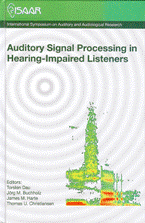Impaired auditory functions underlying degraded speech perception in noise
Abstract
Hearing-impaired people often experience great dif culty with speech communication when background noise is present. In most cases, the problem persists even if reduced audibility has been compensated for by hearing aids. Clearly, other impairment factors besides reduced audibility must be involved. In order to minimize confounding effects, the subjects participating in this study consisted of groups with homogeneous, symmetric audiograms. The perceptual listening experiments assessed the speech intelligibility in the presence of stationary as well as uctuating interferers, the individual’s frequency selectivity and the integrity of temporal fine-structure processing. The latter was addressed by measuring the lateralization threshold for low-frequency tones with ongoing interaural phase delays. In addition, this lateralization threshold was measured in a stationary noise background in order to assess the persistence of the ne- structure processing to interfering noise. This may play a crucial role for the ability to listen into the dips of fluctuating background interferers.
References
Dreschler, W. A., and Plomp, R. (1985). ”Relations between psychophysical data and speech perception for hearing-impaired subjects. II,” J. Acoust. Soc. Am., 78(4), 1261–1270.
Gabriel, K. J., Koehnke, J., and Colburn, H. S. (1992). ”Frequency dependence of binaural performance in listeners with impaired binaural hearing,” J. Acoust. Soc. Am., 91(1), 336–347.
Horst, J. W. (1987). ”Frequency discrimination of complex signals, frequency selectivity, and speech perception in hearing-impaired subjects,” J. Acoust. Soc. Am., 82(3), 874–885.
Kaernbach, C. (1991). ”Simple adaptive testing with the weighted up-down method,” Percept. Psychophys., 49(3), 227–229.
Koehnke, J., Culotta, C. P., Hawley, M. L., and Colburn, H. S. (1995). ”Effects of reference interaural time and intensity differences on binaural performance in listeners with normal and impaired hearing,” Ear. Hear., 16(4), 331–353.
Lacher-Fougère, S., and Demany, L. (2005). ”Consequences of cochlear damage for the detection of interaural phase differences,” J. Acoust. Soc. Am., 118(4), 2519–2526.
Levitt, H., and Rabiner, L. R. (1967). ”Binaural release from masking for speech and gain in intelligibility,” J. Acoust. Soc. Am., 42(3), 601–608.
Lorenzi, C., Gilbert, G., Carn, H., Garnier, S., and Moore, B. C. J. (2006). ”Speech perception problems of the hearing impaired reflect inability to use temporal fine structure,” Proc. Natl. Acad. Sci. USA, 103(49):18866–18869.
Moore, B. C. (1996). ”Perceptual consequences of cochlear hearing loss and their implications for the design of hearing aids,” Ear. Hear., 17(2), 133–161.
Patterson, R. D., and Nimmo-Smith, I. (1980). ”Off-frequency listening and auditory- lter asymmetry,” J. Acoust. Soc. Am., 67(1), 229–245.
Rosen, S., Baker, R. J., and Darling, A. (1998). ”Auditory filter nonlinearity at 2 kHz in normal hearing listeners,” J. Acoust. Soc. Am., 103(5 Pt 1), 2539–2550.
Santurette, S., and Dau, T. (2007). ”Binaural pitch perception in normal-hearing and hearing-impaired listeners,” Hear. Res., 223(1-2), 29–47.
Wagener, K., Josvassen, J. L., and Ardenkjaer, R. (2003). ”Design, optimization and evaluation of a Danish sentence test in noise,” Int. J. Audiol., 42(1), 10–17.
Additional Files
Published
How to Cite
Issue
Section
License
Authors who publish with this journal agree to the following terms:
a. Authors retain copyright* and grant the journal right of first publication with the work simultaneously licensed under a Creative Commons Attribution License that allows others to share the work with an acknowledgement of the work's authorship and initial publication in this journal.
b. Authors are able to enter into separate, additional contractual arrangements for the non-exclusive distribution of the journal's published version of the work (e.g., post it to an institutional repository or publish it in a book), with an acknowledgement of its initial publication in this journal.
c. Authors are permitted and encouraged to post their work online (e.g., in institutional repositories or on their website) prior to and during the submission process, as it can lead to productive exchanges, as well as earlier and greater citation of published work (See The Effect of Open Access).
*From the 2017 issue onward. The Danavox Jubilee Foundation owns the copyright of all articles published in the 1969-2015 issues. However, authors are still allowed to share the work with an acknowledgement of the work's authorship and initial publication in this journal.


